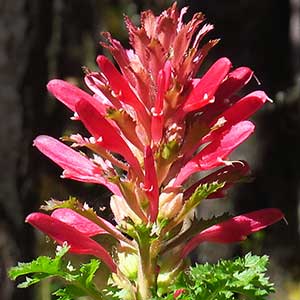Pedicularis densiflora
Pedicularis lapponica
Indian warrior, warrior's plume
Lapland lousewort, pédiculaire de laponie
basal 1–10, blade lanceolate, 30–200 x 20–70 mm, 2(or 3)-pinnatifid, margins of adjacent lobes nonoverlapping or extensively overlapping distally, 1-serrate, surfaces glabrous, hispid, or downy;
cauline 4–20, blade lanceolate, 15–250 x 5–100 mm, 2-pinnatifid, margins of adjacent lobes nonoverlapping or extensively overlapping distally, serrate, surfaces glabrous, hispid, or downy.
basal 0–4, blade lanceolate, 6–25 x 3–13 mm, 1-pinnatifid, margins of adjacent lobes nonoverlapping, serrate, surfaces glabrous;
cauline 3–7, blade lanceolate, 10–35 x 2–6 mm, 1(or 2)-pinnatifid, margins of adjacent lobes nonoverlapping, serrate, surfaces glabrous.
simple, 1–5, exceeding basal leaves, each 10–50-flowered;
bracts lanceolate to trullate, 10–35 x 3–5 mm, undivided or 1-pinnatifid, proximal margins entire, distal 1- or 2-serrate, surfaces glabrous.
simple, capitate, 1–3, exceeding basal leaves, each 6–12-flowered;
bracts linear to triangular, 6–9 x 1–3 mm, undivided or 1-pinnatifid, proximal margins entire, distal serrate, surfaces glabrous.
2–4 mm.
1–2 mm.
calyx 9–18 mm, downy to tomentose, lobes 5, triangular, 3–4 mm, apex entire, ciliate;
corolla 23–43 mm, tube dark red, purple, or orange-yellow, rarely white, 8–18 mm;
galea dark red, purple, or orange-yellow, rarely white, 15–25 mm, beakless, margins entire medially and distally, apex straight;
abaxial lip dark red, purple, or orange-yellow, rarely white, 8–15 mm.
calyx 4–5.5 mm, glabrous, lobes 2, deltate, 0.2–1 mm, apex entire, glabrous;
corolla 11–17 mm, tube yellow, 6–8 mm;
galea yellow, 5–9 mm, beaked, beak straight, 0.5–2 mm, margins entire medially and distally, apex extending over abaxial lip;
abaxial lip yellow, 4–7 mm.
= 16.
= 16.
Pedicularis densiflora
Pedicularis lapponica
Scarlet corollas with an undomed, toothless galea and two- or three-pinnatifid leaves are diagnostic of Pedicularis densiflora. This species occurs in forested subalpine regions of southern Oregon, western slopes of the Sierra Nevada, and the Coast Ranges of California south to Baja California. Herbarium records indicate northern populations of P. densiflora occur at higher elevations than do more southern populations.
(Discussion copyrighted by Flora of North America; reprinted with permission.)
W. J. Cody (2000) described the beak of Pedicularis lapponica as toothed, but this is a misinterpretation of its irregular fimbriate apex that sometimes appears to be toothed. Basal leaves are usually not present on herbarium material, but if present, they are often larger than the cauline leaves but otherwise similar in form.
(Discussion copyrighted by Flora of North America; reprinted with permission.)


